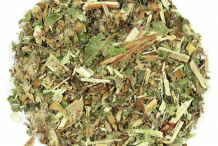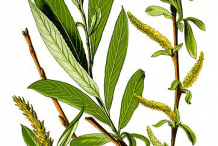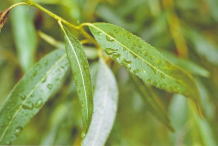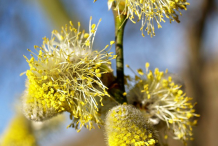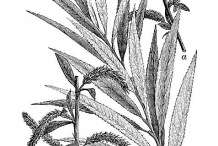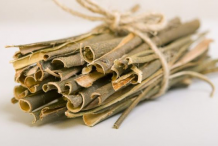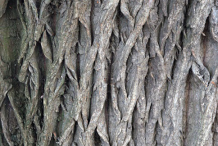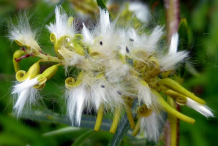| Willow Quick Facts |
| Name: |
Willow |
| Scientific Name: |
Salix alba |
| Origin |
Europe and western and central Asia |
| Shapes |
Small (4 mm) capsules, each containing numerous minute seeds |
| Taste |
Bitter |
| Calories |
592 Kcal./cup |
| Major nutrients |
Total Fat (174.29%)
Iron (16.25%)
Phosphorus (8.29%)
Carbohydrate (6.23%)
Protein (5.20%) |
| Health benefits |
Promotes Healthy Digestion and Reduces Fever |
Salix alba (white willow) commonly known as Bay willow, Black willow, White willow, Willow bark, salix is a large deciduous tree native to Europe and western and central Asia. It was brought to the U.S. in the 1700s by European settlers and has since escaped and naturalized in many parts of North America. The plant belongs to the family Salicaceae and is often found near the lakes and ponds or planted in gardens and parks because of its ornamental morphology. Willow is a symbol of immortality and rebirth in China. In the other parts of the world willow often represents grief. Willow trees are related with mysticism and superstition. According to the legend, witches crafted brooms using the branches of the willow tree.
Plant Description
Willow is a medium-sized to large deciduous tree that grows about 10–30 m tall with a trunk up to 1 m diameter and an irregular, often-leaning crown. The plant is found growing on the margins of lakes and rivers where it may mainly have been planted. It will also grow by ponds, streams, wet hollows and ditches. Normally the plant prefers cool and moist soil. The bark is grey-brown, and deeply fissured in older trees. The shoots in the typical species are grey-brown to green-brown.
Leaves
Leaves are paler than most other willows, due to a covering of very fine, silky white hairs, in particular on the underside. They are 5–10 cm long and 0.5–1.5 cm wide, deciduous, alternate, and commonly elongated and serrated or smooth. Elongated leaves are green on the upper side and whitish on the bottom side. Color of the leaves may changes seasonally. Leaves turn from green to yellow in the autumn.
Flower & Fruit
This is a dioecious species, with flowering catkins appearing on separate male and female trees in May. Male catkins 4–5 cm long are somewhat showy, having tiny flowers with yellowish anthers and two stamens. Female catkins are smaller about 3–4 cm long and non-showy, with greenish flowers. When mature in midsummer, the female catkins comprise numerous small (4 mm) capsules, each containing numerous minute seeds surrounded in white down, which aids wind dispersal. Willow trees are associated with mysticism and superstition. According to the legend, witches crafted brooms using the branches of the willow tree.
Varieties
A number of cultivars and hybrids have been selected for forestry and horticultural use:
1. Salix Alba ‘Caerulea’ (cricket-bat willow)
Salix Alba ‘Caerulea’ (cricket-bat willow) is grown as a specialist timber crop in Britain, mostly for the production of cricket bats, and for other uses where a tough, lightweight wood that does not fragment easily is required. It is distinguished mainly by its growth form, very fast-growing with a single straight stem, and also by its slightly larger leaves (10–11 cm long, 1.5–2 cm wide) with a more blue-green color. Its origin is unknown; it may be a hybrid between white willow and crack willow, but this is not confirmed.
2. Salix Alba ‘Vitellina’ (golden willow)
Salix Alba ‘Vitellina’ (golden willow) is a cultivar grown in gardens for its shoots, which are golden-yellow for one to two years before turning brown. It is mainly decorative in winter; the best effect is achieved by coppicing it every two to three years to encourage the production of longer young shoots with better color. Other similar cultivars include ‘Britzensis’, ‘Cardinal’, and ‘Chermesina’, selected for even brighter orange-red shoots.
3. Salix Alba ‘Sericea’ (silver willow)
Salix Alba ‘Sericea’ (silver willow) is a cultivar where the white hairs on the leaves are particularly dense, giving it more strongly silvery-white foliage. This cultivar has extended the Royal Horticultural Society’s Award of Garden Merit.
4, Salix Alba ‘Vitellina-Tristis’ (golden weeping willow)
Salix Alba ‘Vitellina-Tristis’ (golden weeping willow) is a weeping cultivar with yellow branches that become reddish-orange in winter. It is now rare in cultivation and has been mainly replaced by Salix sepulchralis group ‘Chrysocoma’. It is, however, still the best choice in very cold parts of the world, such as Canada, the northern US, and Russia.
The golden hybrid weeping willow (Salix sepulchralis group ‘Chrysocoma’) is a hybrid between white willow and Peking willow Salix babylonica.
Health Benefits of Willow Bark
White willow bark, the bark obtained from the white willow tree has been used for centuries as a natural remedy for the treatment of fever and also for lowering pain. Bark contains an active ingredient known as salicin, which is converted to salicylic acid by the body. White willow bark has several benefits and there are scientific proofs to support this fact, which is why it has become a very popular and trusted alternative remedy for various health issues. Here are some of the important benefits of using willow bark
1. Relieves Pain
Due to its rich blend of antioxidants and organic compounds, willow bark functions as a very successful analgesia. For thousands of years, it has been traditionally used to relieve pain from injuries and illness, with great success. In fact, more than 2,500 years ago, the earliest recorded use of an herb was of willow bark, in Chinese traditional medicine. Although it was stated in older texts dating back to the Egyptians, this was the first recognized use of willow bark for pain relief! (1)
2. Anti-inflammatory Properties
Inflammation takes on many different forms within our body. If you are looking to eliminate the inflammation in your respiratory tracts, gastrointestinal system, or joints, then willow bark can quickly soothe your symptoms. If you prepare a decoction or a tea of this bark, you will feel the inflammation and topical pain from arthritis, irritable bowel syndrome, gout, and other conditions disappear.(2)
3. Reduces Risks of Cancer
White willow consists of good amount of antioxidant and anti-inflammatory properties that helps to reduce the risks of cancer. Since it acts as an antioxidant, white willow has proven its benefit to protect against viruses and bacteria in the body. Also, it strengthens body immune system. Not only for that, the anti-inflammatory properties contained in white willow help to reduce inflammation which happens due to the bad environmental exposure and toxins. Hence, as the anti-inflammatory properties also prevent free radicals, thus it is beneficial to prevent the risks of cancer as well.
4. Soothes Stomach Disorders
High content of tannins help soothe the stomach and prevent gastrointestinal distress during other illnesses or periods of a weakened immune system. While willow bark can be slow-acting, its effects can be long-lasting, making it an effective herbal remedy to occasionally add to your health regiment, but it should not be consumed daily unless recommended by a doctor or trained herbalist. (3)
5. Eliminates Migraines
If you suffer from chronic headaches and migraines, you might be able to benefit suggestively from the pain-relieving qualities of willow bark. It can help eliminate migraines by lowering the blood pressure in the small capillaries and blood vessels in the head, easing pressure and relieving those painful, debilitating symptoms. It can also be used as a preventative method for regular headaches.(4)
6. Relieves Toothache
Toothache is so annoying; hence you should find the right treatment and prevention. Gargling white willow bark tea before going to sleep is quite beneficial to get relieve from toothache. You can chew on a white willow bark regularly to deal with the toothache. Certainly, as white willow bark has the analgesic properties, it is beneficial to be a natural treatment for a toothache.
7. Reduces Fever
Anti-inflammatory properties of willow bark are quite beneficial for reduction of fevers. Fevers are a symptom of an infection in the body, but reducing a fever or “breaking” it is important to speed up the healing process and get the organ systems working normally again. It has been used to treat fevers for thousands of years. (5)
8. Eases Menstruation
For many women who suffer from abnormally heavy periods or severe menstrual symptoms, taking a small glass of willow bark can do wonders for everything from period pains and cramping to mood swings and unnecessary stress hormones in the body. Its relaxing characteristics are particularly good in these circumstances, as they can help to re-balance hormones in a woman’s body. (6)
9. Weight Loss Efforts
Many people turn to willow bark to boost weight loss efforts, because the herb combines so well with other fat-burning and metabolism-boosting substances. It can strengthen the effects of these herbs in a healthy way, thus increasing their efficacy and improving your results even further.(7)
10. Treats Back Pain
White willow is supposed as an effective treatment for back pain. As described before, white willow is a really great plant to help in relieving the pain caused by the presence of salicin. Therefore, if you suffer from back pain, it is suggested to consume white willow bark frequently to help with this kind of disease. And, do not forget to take a rest, lovely people!
11. Skin Care
The appearance of the skin is very important for us. High content of antioxidant compounds found in willow bark have a major impact on the health of the skin. Whether applied topically or consumed, willow bark helps to increase blood flow to the skin due to its antioxidants, while also reducing the appearance of wrinkles and age marks. Additionally, it can eliminate inflammation in the skin and ease the pain of insect bites and irritation.
12. Maintains the Healthy Heart
Doing a healthy lifestyle together with consuming the best foods is the perfect combination to maintain the healthy heart. You will get super benefits by doing that kind of actions. If you consume white willow, then you help yourself to reduce the risks of internal clotting which is related with the heart disease including stroke and heart attack. Additionally, it has shown that white willow bark contains salicylates which have the same effect as aspirin to maintain the heart health.
13. Promotes Healthy Digestion
To maintain the great digestive system, you have to consume best foods which are rich in fiber including fruits and green vegetables. At this point, consuming white willow will be such a great idea, too. Willow consists of good amount of tannins which is valuable to calm the stomach and prevent gastrointestinal distress. Thus, what are you waiting for? Try to eat white willow to promote the body health.
14. Removes Warts
Willow consists of good amount of salicylic acid which has shown a great result in removing warts. Thus, if you want to eliminate warts thoroughly without cause much pain, then white willow is the perfect solution for you. Indeed, not only to remove warts, you can have the clear skin by having white willow as the option.
15. Treats Psoriasis
Psoriasis is one of skin disorders which cause the skin cells be multiplied up to 10 times faster than normal. This disease often occurs on certain body parts such as the knees, elbows, and scalp. Moreover, the symptoms are various including the presence of red skin plaques and plaques of scales or crust on the scalp.
As a result, one of the natural treatments for this skin disorder is to have white willow as the option. Thus, you can mix the willow bark with the oak and walnut leaves and then pour the boiling water over them. After that, you drink it 3 times per day regularly to speed up the healing process.
16. Relieve Sciatica Pain
White willow bark consists of salicin and phenolic glycosides that help in relieving sciatica pain. These can give you anti-inflammatory and analgesic benefits. People with sciatica pain ought to take a willow bark having 120 or 240 milligrams of salicin every day for several weeks. However, remember to consult a doctor before using this bark.
17. Removes Acne
Everyone hates acne, doesn’t it? As a result, many people try to obtain the clear and beauty skin by having some beauty treatments. Yet, you can have the alternative one by using natural plants and fruits for the facial mask. Thus, white willow offers you the anti-inflammatory and soothing properties, and then it is useful to be a natural exfoliant. Hence, you will be as happy as this kind of plants helps to remove skin dead cells and help with skin rejuvenation.
18. Promotes Beauty Skin
With the antioxidant properties, white willow takes part in promoting the beauty and healthy skin. White willow will help you to reduce the wrinkles and age marks as well as relieving the skin irritations.
19. Improve Kidney Failure
The antioxidant, anti-inflammatory, & antiseptic effects present in the white willow bark can aid in improving the kidney failure and ease the pain. Furthermore, its immune boosting effects make your kidneys function better. You can make a tea with the dried white willow bark and drink it 3 to 4 times per day for this purpose.
https://www.youtube.com/watch?v=nLXRp5aOZ2U
Traditional uses and benefits of Willow
- Hippocrates, Galen, Pliny the Elder and others knew willow bark could ease aches and pains and reduce fevers.
- White willow and several closely related species have been used for thousands of years to relieve joint pain and manage fevers.
- Bark is anodyne, anti-inflammatory, antiperiodic, antiseptic, astringent, diaphoretic, diuretic, febrifuge, hypnotic, sedative and tonic.
- It has been used internally in the treatment of dyspepsia connected with debility of the digestive organs, rheumatism, arthritis, gout, inflammatory stages of auto-immune diseases, feverish illnesses, neuralgia and headache.
- Its tonic and astringent properties render it useful in recovery from acute diseases, in treating worms, chronic dysentery and diarrhea.
- Fresh bark is used as an anodyne and febrifuge.
- Leaves are used internally in the treatment of minor feverish illnesses and colic.
- An infusion of the leaves has a calming effect and is helpful in the treatment of nervous insomnia.
- When added to the bath water, the infusion is of real benefit in relieving widespread rheumatism.
- It is suggested for Arthritis and bursitis.
- It eases the inflammation in the joints and the tendons.
- It gives relief from all kinds of body aches like headache, muscle ache, muscle cramps and back ache.
- It reduces toothache and inflamed gums.
- It is beneficial for healing mouth ulcers and sores.
- It is effective when applied on cuts, wounds and burns.
- Antiviral and antibacterial property of the herb helps to combat the infectious diseases.
- It helps to lower the body temperature in fever.
- It is an excellent herb for neuralgia, cardiovascular disorders and carpel tunnel syndrome.
- It eases the painful menses and enhances the blood flow.
- People chewed bark of the willow tree to treat fever, inflammation and pain in the past.
Ayurvedic Health benefits of Willow
- Arthritis: Cut the bark of white willow. Boil it. Add ginger to activate willow bark. Drink twice a day.
- Bursitis: Take 2 grams of ground bark. Mix it in 8 ounces of water. Drink up to 4-5 cups per day.
- Kidney diseases: Prepare a white Willow bark tea. Drink it thrice a day to get relief from kidney pain.
- Frozen Shoulder: Boil white willow bark in water for 10 minutes. Strain and consume this daily.
- Bunion: Prepare a tea from the fresh leaves of white willow. Drink it twice a day. OR Prepare a paste of white willow bark. Apply it on bunions.
- Difficult Menses: Take half tbsp of white willow bark powder. Boil it in water for 5 to 10 minutes. Have this tea 2 times in a day. It eases menstrual cramps and good for irregular periods.
- Obesity: Take Ephedra’s leaves and white willow bark in 1: 2 ratios. Make its decoction. Drink 5 ml of it once a day.
Culinary Uses
- Inner barks are raw or cooked.
- It can be dried, ground into a powder and added to cereal flour then used in making bread etc.
- It is used as a famine food when all else fails.
- Leaves and young shoots are consumed raw or cooked.
- The leaves can be used as a tea substitute.
Forms and dose of willow bark
Capsules
Willow bark can be purchased from many drugstores and almost any health food store in a powdered, encapsulated form. The recommended dose for pain relief is 240 milligrams a day.
Bark
Active ingredient in willow bark is salicin, but the accompanying flavonoids and plant particles might be part of what make willow bark effective. For this reason, some people prefer to actually chew on the unprocessed bark of the willow tree. It is difficult to control how much salicin you are getting from each piece of bark, so this method of consumption should be approached with caution.
Liquid
Willow bark can also be found in a distilled tincture form. Taking a drop or two per day for pain relief (up to 2 milliliters) can work as an anti-inflammatory and pain relief substitute for aspirin.
Tea
Some health food stores sell willow bark tea, advertising it as a pain reliever and anti-inflammatory. Steep willow barks tea for two to three minutes in hot water. When consuming willow bark in this form, it’s hard to tell how much salicin you are getting in each serving of tea.
Topical
Willow bark can be used topically. Since it isn’t absorbed digestively, topical willow bark is a good alternative for those who commonly experience stomach ulcers. However, topical use can be harsh and cause skin irritation.
Other Facts
- Stems (withies) from coppiced and pollarded plants are used for basket-making.
- Charcoal made from the wood was important for gunpowder manufacture.
- Bark tannin was used in the past for tanning leather.
- Wood is used to make cricket bats.
- Bark is often softened in ethanol to produce a tincture.
- Young stems are very flexible and are used in basket making.
- Bark can be used for tying plants.
- Fiber obtained from the stems is used in making paper.
- A fast growing tree can be grown as a shelterbelt.
- Wood is elastic, soft, easy to split, does not splinter.
- Woods are used for construction, turnery, poles, tool handles etc.
- Wood is also used to make charcoal, which has medicinal uses.
- Willow is one of the fastest growing plants in the world. It can grow 10 feet in height each year.
- Willow tree is used in the manufacture of baskets, fishing nets, furniture and toys.
- Dyes extracted from the willow trees are used for tanning of the leather.
- Willow wood is used in the manufacture of boxes, brooms, cricket bats, cradle boards, chairs and other furniture, dolls, flutes, poles, sweat lodges, toys, turnery, tool handles, veneer, wands and whistles.
- Willow is used to make living sculptures.
- Willow stems are used to weave three-dimensional sculptures, such as animals and figures.
Special Precautions & Warnings
Pregnancy & Breast Feeding: It might be unsafe for breastfeeding women to use white willow bark. It contains chemicals that have harmful impacts on the nursing infant. Avoid using it if you are a breastfeeding woman.
It has not enough evidence about the safety of willow bark during pregnancy. However, it is better to avoid using it.
Children: White willow bark may be unsafe for children when consumed for viral infections including flu and colds. Like aspirin, it may increase the risk of Reye’s syndrome. Although it is still on the safe side, don’t use it for children.
Kidney disease: White willow bark may reduce blood flow to the kidneys, which may result in kidney failure in some people. If you suffer from kidney disease, avoid using this bark.
Bleeding disorders: White willow bark may increase the chance of bleeding in people who have bleeding disorders.
Sensitivity to aspirin: Those with stomach ulcers, asthma, diabetes, gout, hypo-prothrombinemia, hemophilia, or liver or kidney disease may be sensitive to willow bark. Using this bark may cause serious allergic reactions. Never use it.
Surgery: White willow bark may slow blood clotting. It could cause extra bleeding in and after surgery. Avoid using this bark at least two weeks before a surgery.
References:
http://www.theplantlist.org/tpl1.1/record/kew-5001521
https://plants.usda.gov/core/profile?symbol=saal2
https://npgsweb.ars-grin.gov/gringlobal/taxonomydetail.aspx?id=32674
http://www.pfaf.org/user/Plant.aspx?LatinName=Salix+alba
https://www.mskcc.org/cancer-care/integrative-medicine/herbs/willow-bark
http://www.missouribotanicalgarden.org/PlantFinder/PlantFinderDetails.aspx?taxonid=286791&isprofile=0&
http://www.floracatalana.net/salix-alba-l
http://www.botanical.com/botanical/mgmh/w/wilwhi22.html
https://www.itis.gov/servlet/SingleRpt/SingleRpt?search_topic=TSN&search_value=565478#null
https://en.wikipedia.org/wiki/Willow
Comments
comments





